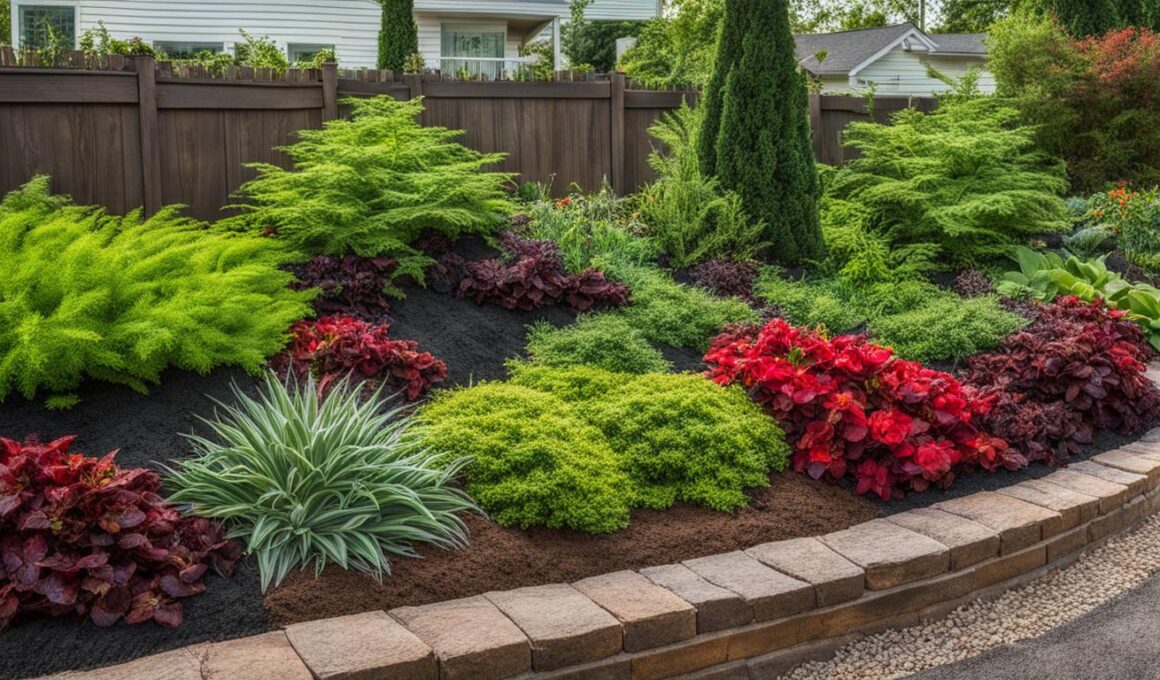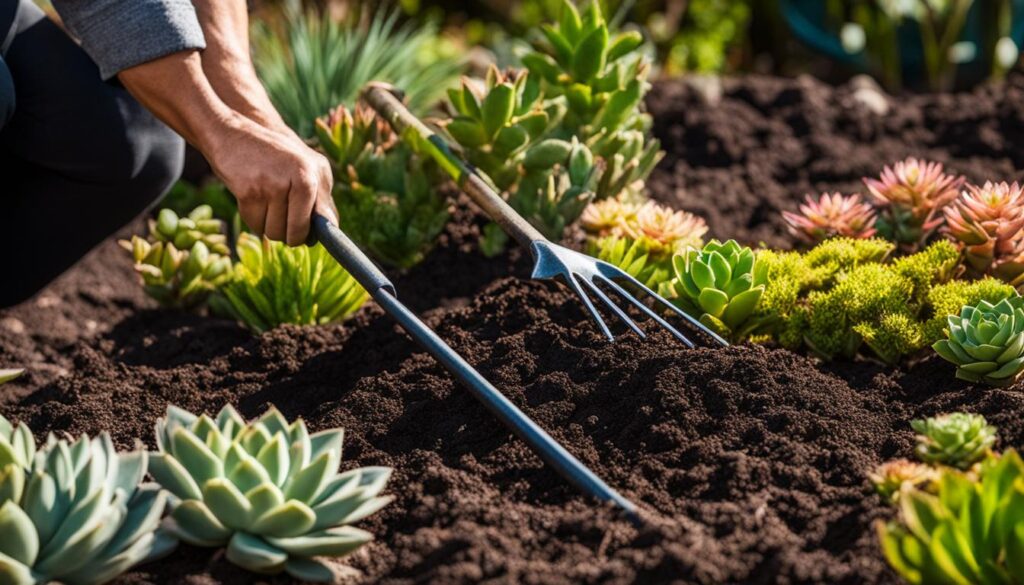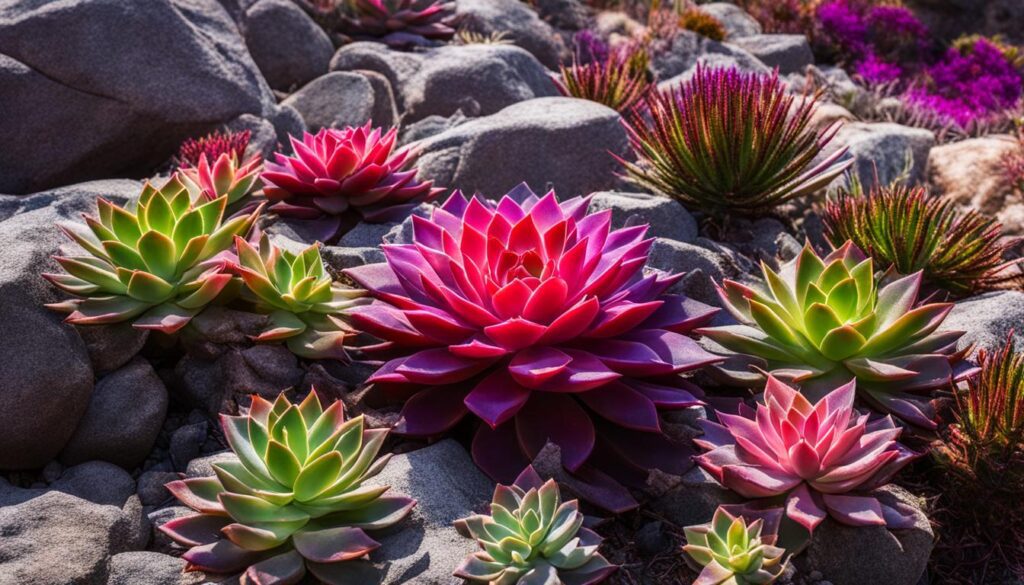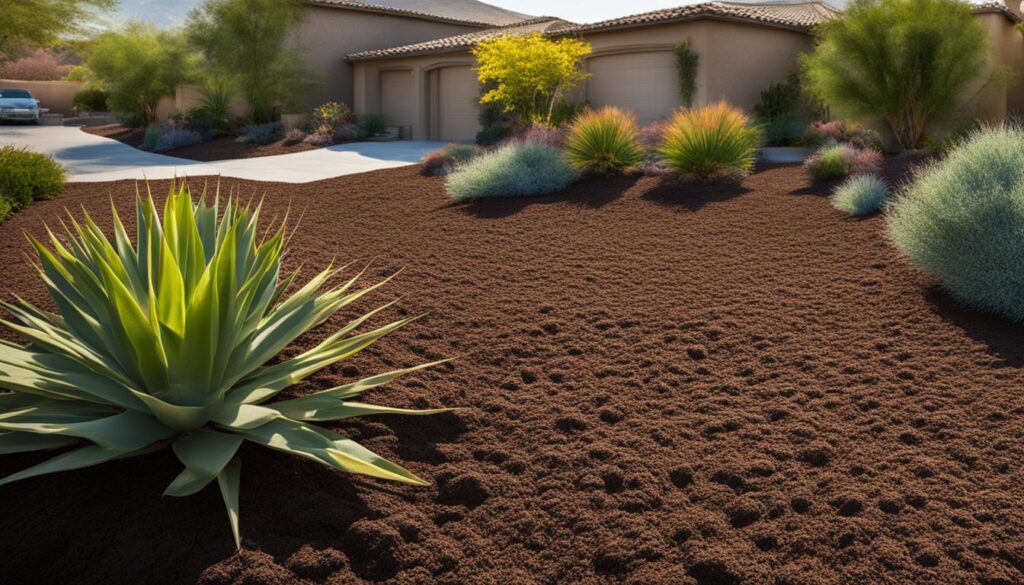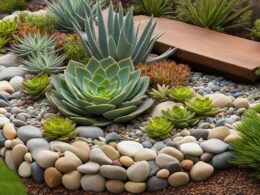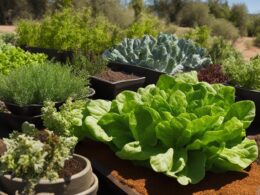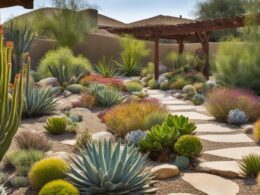Welcome to our guide on mastering mulching techniques for xeriscape zones. If you’re looking to conserve water, improve plant health, and beautify your xeriscape garden, implementing these mulching techniques is essential. By understanding the importance of mulch and how to use it effectively, you can create a sustainable and thriving garden in arid regions.
Key Takeaways:
- Mulching is crucial for water conservation in xeriscape gardening.
- Mulch helps limit water evaporation, suppresses weed growth, and improves air and water circulation.
- Selecting the right mulching material, such as landscape fabric, shredded bark, wood chips, or rocks, is important for optimal results.
- Proper mulching techniques promote plant health, reduce maintenance, and enhance the overall beauty of your xeriscape garden.
- Remember to plan and design your garden, improve the soil, select low-water requirement plants, and use mulch to maximize water conservation.
Understanding Xeriscape and its Benefits
Xeriscape is a sensible gardening method developed to conserve water in arid regions, particularly in the American West. The term “xeriscape” comes from the Greek words “xeros,” meaning dry, and “landscape.” This approach aims to minimize water usage while maintaining beautiful, sustainable gardens. By implementing xeriscape techniques, you can not only save water but also contribute to environmental conservation.
Xeriscape gardening has numerous benefits, particularly in regions with limited water resources. By using water-efficient plants and reducing irrigation needs, xeriscapes significantly decrease water consumption compared to traditional gardening methods. This not only conserves water but also helps preserve the environment and protects the arid natural landscapes of the American West. Moreover, xeriscapes require less maintenance, reducing the need for mowing, trimming, and other time-consuming gardening tasks.
“Xeriscape gardening is a practical and sustainable solution, allowing you to enjoy a beautiful garden while preserving precious water resources.”
Through sensible gardening methods, xeriscaping promotes the use of drought-tolerant plants that can thrive in harsh conditions. These plants are carefully selected based on their water requirements, adaptability to arid climates, and ability to withstand temperature fluctuations. By incorporating native plant species, xeriscapes create habitats for local wildlife, supporting biodiversity and ecological balance.
| Benefits of Xeriscape Gardening |
|---|
| Conserves water |
| Protects the environment |
| Reduces maintenance |
| Promotes drought-tolerant plants |
| Supports local wildlife |
| Enhances aesthetic appeal |
By understanding the concept and benefits of xeriscape gardening, you can make informed decisions about implementing this environmentally friendly approach. The next section will delve into the planning and design aspects of creating a xeriscape garden, ensuring you create a sustainable oasis that conserves water and enhances the beauty of your outdoor space.
Planning and Designing a Xeriscape Garden
When it comes to creating a successful xeriscape garden, proper planning and design are essential. Consider the unique aspects of your space, such as the microclimate, water source, slope, and space requirements. By taking these factors into account, you can create a garden that thrives with minimal water usage.
Start by drawing a sketch of your site, noting the sunlight exposure, prevailing winds, and shade from nearby trees. This will help you determine which areas receive the most sunlight and which may need additional shade. Understanding the microclimate of your garden is crucial in selecting the right plants and design elements.
Next, identify the location of your water source. Determine how water will be delivered to your plants, whether through overhead irrigation, drip systems, or a combination of both. This will influence the layout and design of your garden, ensuring efficient water distribution.
Space requirements are another essential consideration. Determine the size and shape of your garden beds, pathways, and seating areas. Leave enough space between plants to allow for growth and air circulation. Proper spacing promotes healthy plant development and reduces the risk of disease and pest infestation.
Example Table: Plant Selection for Different Microclimates
| Microclimate | Sun Exposure | Plant Recommendations |
|---|---|---|
| Full Sun | 6+ hours of direct sunlight per day | Yucca, Agave, Lavender |
| Partial Shade | 4-6 hours of direct sunlight per day | Penstemon, Coyote Mint, Verbena |
| Full Shade | Less than 4 hours of direct sunlight per day | Ferns, Heuchera, Hosta |
Selecting the right plants for your xeriscape garden is crucial. Choose plants that are well-suited to your microclimate and require minimal water. Consider the height, color, and blooming season of each plant to create an aesthetically pleasing and diverse garden. Consulting local resources and visiting xeriscape demonstration gardens can provide valuable insights and inspiration for plant selection.
By carefully planning and designing your xeriscape garden, taking into account the microclimate, water source, slope, and space requirements, you can create a beautiful and sustainable landscape that thrives with minimal water usage.
Improving the Soil for Xeriscape Gardens
Xeriscape gardening requires special attention to soil quality, especially in regions like Colorado where sandy or clay-based soils are prevalent. By improving the soil composition, you can create a healthy foundation for your xeriscape garden and ensure the optimal growth of your plants.
To improve Colorado soils for xeriscape gardening, the addition of organic matter is crucial. Organic matter such as aged manure or compost helps enhance the soil’s texture and structure, allowing for better water absorption and retention. It also promotes nutrient availability and microbial activity, which are vital for plant health.
“Adding organic matter to your soil is like giving it a nutritious meal. It provides the necessary elements for your plants to thrive and ensures the overall success of your xeriscape garden.” – Gardening Expert
For sandy soils, the addition of organic matter helps in water retention, preventing excessive drainage. It also improves nutrient holding capacity, ensuring that plants receive adequate nourishment. On the other hand, clay soils tend to be heavy and compacted, making it difficult for water and air to penetrate. Organic matter helps loosen the soil, providing better drainage and aeration for plant roots.
| Soil Type | Improvement Techniques |
|---|---|
| Sandy Soil | Add 2-4 inches of organic matter, such as compost or aged manure, and mix it thoroughly with the existing soil. This will improve water retention and nutrient availability. |
| Clay Soil | Add 4-6 inches of organic matter and dig it into the soil. This will help improve drainage and aeration, preventing waterlogging and root suffocation. |
Improving the soil is a fundamental step in establishing a successful xeriscape garden. It sets the stage for healthy plant growth, efficient water usage, and long-term sustainability.
Selecting the Right Plants for Xeriscape Gardening
When it comes to xeriscape gardening, choosing the right plants is essential for creating a beautiful and low-maintenance landscape that thrives with minimal water. By selecting low-water requirement plants, you can ensure the sustainability and success of your xeriscape garden.
When choosing plants for xeriscape gardening, consider their ability to tolerate drought conditions and their overall water needs. Look for plants that are well-suited to your specific climate and soil type. Native plants are often a great choice as they are naturally adapted to the local environment and require less water.
Consider the height, color, and blooming season of the plants to create an aesthetically pleasing landscape. Mixing different plant varieties can add visual interest and create a more dynamic garden. By selecting a variety of plants that bloom at different times of the year, you can ensure that your xeriscape garden remains vibrant and attractive throughout the seasons.
Visiting xeriscape demonstration gardens and consulting local resources, such as gardening experts or nurseries, can provide valuable insights and recommendations for plant selection. These resources can help you identify the best plants for your specific climate and soil conditions, ensuring the long-term success of your xeriscape garden.
Table: Low-Water Requirement Plants for Xeriscape Gardens
| Plant Name | Water Requirements | Bloom Season |
|---|---|---|
| Agave | Low | Spring, Summer |
| Lavender | Low | Summer |
| Sedum | Low | Summer, Fall |
| Yarrow | Low | Spring, Summer |
| Penstemon | Low to Moderate | Spring, Summer |
Table notes: This table showcases a selection of low-water requirement plants that are well-suited for xeriscape gardens. These plants require minimal water once established and provide beautiful blooms during specific seasons. Adjust the plant selection based on your specific location, climate, and soil conditions.
The Importance of Mulching in Xeriscape Gardens
Mulching is a vital practice in xeriscape gardening, offering numerous benefits for your garden’s health and water conservation efforts. By understanding the importance of mulching, you can make informed decisions to enhance the beauty and sustainability of your xeriscape garden.
Water Evaporation Control
One of the key advantages of mulching is its ability to reduce water evaporation from the soil surface. By applying a layer of organic mulch, such as shredded bark or wood chips, you create a protective barrier that slows down the evaporation process. This helps to retain moisture in the soil, ensuring your plants have a consistent water supply even in drought-prone areas.
Suppressing Weed Growth
Mulching also plays a crucial role in preventing weed growth in your xeriscape garden. By covering the soil with mulch, you block sunlight from reaching weed seeds, inhibiting their germination and growth. This minimizes the competition for water and nutrients, allowing your xeriscape plants to thrive without the interference of invasive weeds.
Promoting Air and Water Circulation
In addition to water conservation and weed control, mulching facilitates proper air and water circulation in your xeriscape garden. The layer of mulch acts as an insulator, protecting the soil from extreme temperature fluctuations and reducing soil compaction. This creates a favorable environment for beneficial microorganisms and root growth, ensuring efficient nutrient absorption and overall plant health.
By recognizing the importance of mulching in xeriscape gardens, you can employ this technique to maximize water conservation, minimize weed growth, and promote a healthy and thriving landscape. Implementing mulching as part of your xeriscape gardening practices will contribute to the long-term sustainability and beauty of your garden.
What are the Best Mulching Techniques for Xeriscape Zones in Various Climates?
When it comes to achieving effective xeriscape mulching climates in various regions, it’s important to consider different techniques for conserving moisture and preventing weed growth. In arid zones, using organic materials like wood chips can help retain moisture, while in wetter climates, using gravel or rocks can provide effective mulching benefits.
Conclusion
By implementing the mulching techniques discussed in this article, you can effectively conserve water, improve plant health, and enhance the beauty of your xeriscape garden. Xeriscape gardening is not only environmentally friendly but also sustainable in arid regions.
In summary, to create a thriving xeriscape garden, remember to plan and design your garden, improve the soil, select low-water requirement plants, and use mulch for maximum water conservation. Proper planning and design will ensure that your garden is tailored to the unique needs of your environment. Adding organic matter to your soil will improve its texture and promote better water absorption. Choosing the right plants based on their location, height, color, and blooming season will add beauty to your garden while minimizing water usage. Lastly, mulching will help conserve water by reducing evaporation, suppressing weed growth, and facilitating air and water circulation.
Start applying these techniques today and enjoy the benefits of a thriving xeriscape garden that not only saves water but also contributes to a sustainable future. With xeriscape gardening and effective mulching, you can create a beautiful and eco-friendly oasis in even the driest of climates.





